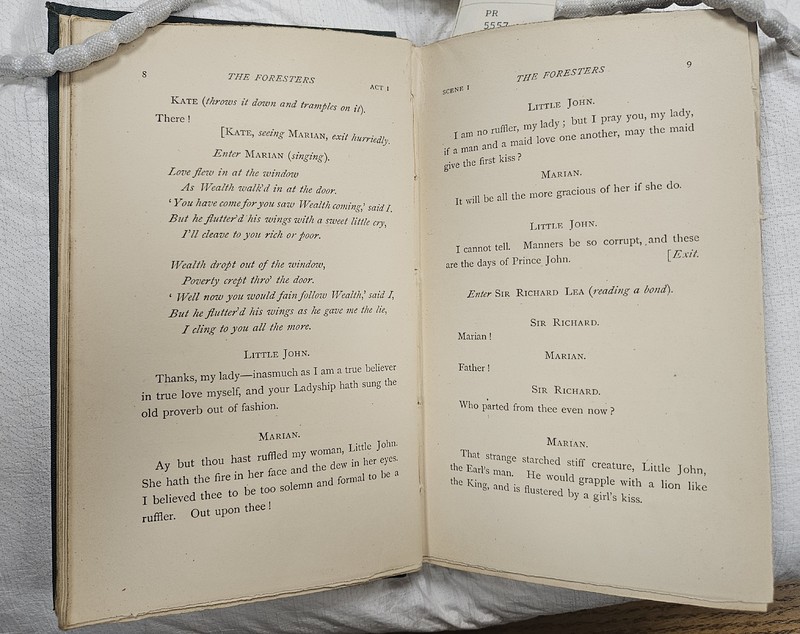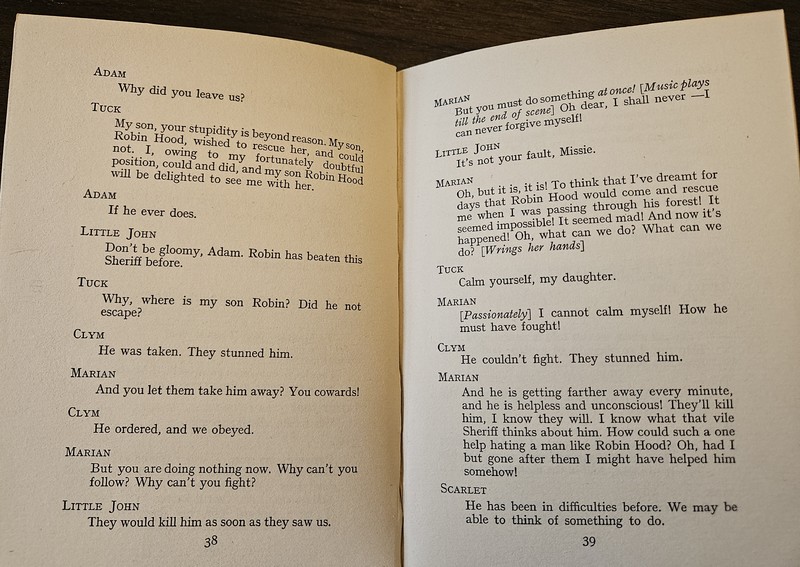Acting Out Maid Marian
This selection of works contain Maid Marian represented through scripts of live theatre. In all four pieces, maid marion’s dialogue is intended as spoken, on stage, and through the embodiment of an actress. These four were chosen to be represented together because of the physical nature of these pieces, as the words must be imagined not only through the text on the page, but also as an actress bringing Marian to life.

The Sad Shepherd, 1783
Marian is described as “[Robin Hood’s] Lady, the Mistris” in the character list preceding the play. Beginning with undertones of unimportance, Maid Marian contradicts this at many turns. This play is the earliest written of the entire selection, despite being of excellent condition for its time, and assuming age it could be assumed that this would have the least progressive interpretation of Maid Marian. Despite this, her actress plays the most important role in the story, as Marian returns from hunting to have her form taken over by Maudlin the witch. While Marion’s character remains in a damsel-in-distress position for most of the play, her actress is the lead villain with a story-line and character-arch to match.

The Foresters, 1892
Marian is described as “the daughter of Sir Richard Lea” preceding this play, continuing to place her character's value on so-called ownership. Her appearances throughout this play are few, but each one makes Marian stand out as a fierce character. While she has lines such as “I am none of your delicate Norman maidens who can only broider and mayhap ride a-hawking with the help of the men” she can contradict this with lines like “The sheriff dare to love me? me who worship Robin the great Earl of Huntingdon?” Due to the time period and Baron status of the author, it was unlikely that the love interest took on any role other than through the leading man’s gaze. Her proud and assertive portrayal is brave for the time and shows her as confident in her damsel-in-distress role.

Sherwood, 1911
Marian’s character in this play is diminishing from previous roles. The damsel-in-distress narrative is leaned into heavily, and the actress would appear pathetic and helpless. In fact, one of Marian’s lines is “Were I a man and not a helpless girl, You should not live!” so the sexism lies, quite clearly, on the surface of this script. The play itself has beautiful coloured illustrations, and the 1911 date does introduce more modernity to the story. However, Marian Fitzwalter is reduced to a kidnapping subject at the whim of her father, capturers, and the foresters.

Robin Hood, a Farcical Romantic Pastoral, 1928
This play credits Miss Jean Carnegie as the first actor portraying Marion De Burgh. Future actors are suggested to play Marion as “Rosalindish, vivacious, but more daring and male,” suggesting that Marion’s character is not stereotypically female. While this is stated, Marion’s actions in the play do not appear as far from the damsel-in-distress narrative as first assumed. Her voice is strong, stubborn, and she speaks her mind freely to her father and other male figures in the story. However, her actions are not nearly as daring as the actor is suggested to be. At the peak of the play, with men fighting over her possession, she threatens suicide by holding a dagger to her chest. Her actions are only to serve her love for Robin, and despite numerous occasions of dialogue demanding action, the scene of threatened death is the only one in which Marion steps out of a damsel-in-distress role.